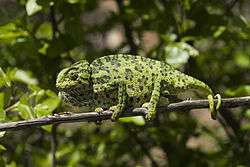Common chameleon
| Common chameleon | |
|---|---|
| | |
| Scientific classification | |
| Kingdom: | Animalia |
| Phylum: | Chordata |
| Class: | Reptilia |
| Order: | Squamata |
| Suborder: | Sauria |
| Family: | Chamaeleonidae |
| Genus: | Chamaeleo |
| Species: | C. chamaeleon |
| Binomial name | |
| Chamaeleo chamaeleon (Linnaeus, 1758) | |
The common chameleon or Mediterranean chameleon (Chamaeleo chamaeleon), together with the African chameleon, C. africanus, is one of only two extant species of Chamaleonidae with a range that extends into Europe.
Basic Information
The common chameleon like others of its family enjoys an arboreal habitat, scrambling about in trees and bushes with feet that have four toes, two on each side for grasping branches. It also uses its prehensile tail to maintain balance and stability. Movement is usually leisurely, often with a slight swaying motion to avoid detection by predators. The animal can move more rapidly when involved in a territorial dispute. They are usually solitary animals which maintain a territory and only tolerate members of the opposite sex during the mating season. Average length of the common chameleon is from 20 to 40 cm, with females often being substantially larger than males. The colour of the common chameleon is variable, between yellow/brown through green to a dark brown. Whatever the background colour is the common chameleon will have two light coloured lines along its side. It has a small beard of scales and some small hard scales on the top of its back. Many assume the color changes undergone by the chameleon are a result of its attempting to camouflage itself, when in reality the chameleon changes its color as a response to light and temperature stimuli and as an expression of its emotions (like chameleon body language). Often when caught for analysis, the chameleon may turn a dark color, Their colors are also important for interspecies communication, especially during the mating season.[2]

Diet
The common chameleon is insectivorous, capturing insects by stealth and the rapid extension of its long tongue which has a terminal pad which grasps and adheres to the prey. Adults are known to eat young chameleons and have been observed to eat fruit.[2]
Reproduction
The common chameleon is sexually mature within one year and the females produce one clutch of eggs per year. Larger females produce more eggs and are more attractive to males who will fight over a female. The mating season for the common chameleon is from mid-July to mid-September. The animals descend to lowers levels of vegetation or to the ground to search for a mate. The eggs are laid in the soil and take from 10–12 months to incubate. Adult animals, especially males, will eat young that they encounter[2]
Distribution

In Europe, it is only autochthonous to the Iberian Peninsula: southern Spain and Portugal,[3][4] Cyprus and the Greek island of Crete. Nevertheless, it has been successfully introduced into other Greek islands, Canary islands and Malta. The species was introduced to Sicily in the early 19th century but its current presence has not been confirmed. A small introduced population is reported to be present in Apulia in southeastern Italy.
In North Africa and the Middle East, it occurs in Morocco, Algeria, Tunisia, Libya, Egypt,[5] Israel, Palestine, Jordan, Western Sahara, Saudi Arabia, Yemen, Lebanon, Syria, Iraq, and Iran. In Greece the species is now only found on the island of Samos, having disappeared from the other islands in recent years. Conservation efforts on Samos are being led by the institute of Marine Biology Archipelagos to preserve the remaining populations, but the species is not currently evaluated under the IUCN redlist.
Conservation and threats
The primary threats to the common chameleon are habitat loss by human intervention and capture for the pet trade (both illegal and legal, depending on the country). Many die of stress or depression upon capture before they make it to the intended destination; capture from the wild is often the most damaging threat to the species. The species is also extremely territorial, and habitat loss has caused strain in finding suitable nesting environments since adult males have been known to attack and eat young that intrude on their domains.
Subspecies
Four subspecies are identified:
- C. c. chamaeleon
- C. c. musae
- C. c. orientalis
- C. c. rectricrista
References
- ↑ Vogrin, M., Corti, C., Pérez Mellado, V., Sá-Sousa, P., Cheylan, M., Pleguezuelos, J., Baha El Din, S. & Al Johany, A.M.H. 2012. Chamaeleo chamaeleon. In: IUCN 2012. IUCN Red List of Threatened Species. Version 2012.2. <www.iucnredlist.org>. Downloaded on 27 October 2012.
- 1 2 3 "Mediterranean Chamaeleon". Arkive. Retrieved 9 Aug 2013.
- ↑ http://repositorio.ul.pt/bitstream/10451/6136/1/ulfc092916_tm_patricia_bras.pdf
- ↑ Blasco, M. 1997. Chamaelo chamaeleon (Linnaeus, 1758) Camaleón común, Camaleão. In: Pleguezuelos, J.M., ed. Distribución y Biogeografía de los anfibios y Reptiles en España y Portugal. Granada, Editorial Universidad de Granada, pp. 190–192.
- ↑ Baha El Din, Sherif (2006). A Guide to Reptiles & Amphibians of Egypt. Cairo: The American University in Cairo Press. ISBN 978-9774249792.
External links
| Wikimedia Commons has media related to Chamaeleo chamaeleon. |
